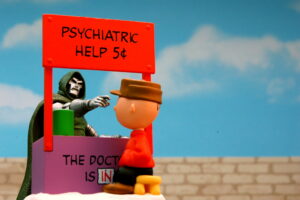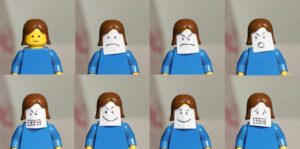Chapter 7: Schizophrenia and Psychotic Disorders
Overview of the Schizophrenia Spectrum
The schizophrenia spectrum was devised because it appears as though there is not one singular disorder, but a syndrome composed of many sub-categories. Therefore, if an individual is on the spectrum, symptoms may be severe and debilitating or they may present as mild (Spectrum Disorder, 2022). A spectrum proficiently unifies these sub-categories, not just for schizophrenia, but other disorders as well. An important note: According to the National Institute for Mental Health, the CDC has identified a connection between those with mental disorders, like schizophrenia, are significantly more likely to be severely affected by COVID-19 (2022).
Schizophrenia symptoms vary from one individual to another, but there are three general groups of symptoms: Psychotic, Negative, and Cognitive. Review each type below, flipping the card to see more details by selecting “Turn”. After reviewing a card, select the right pointing arrow to move to the next card. There are three cards to review (NIMH, 2022).
Schizophrenia

Criteria to Diagnose: Schizophrenia is a severe psychotic disorder that involves disturbed cognition paired with extreme emotional responses and behaviors (American Psychological Association, 2022). The individual must experience these disturbances for at least six months while also at least one month of “active-phase symptoms” like delusions, hallucinations, disorganized speech, catatonic behavior, and “negative” symptoms like lack of emotion (American Psychological Association, 2022). The key symptom in this disorder is disorganized thinking. Disorganized thinking is defined as “disjointed and incoherent thought processes” (OSC Rice University).
Typical Demographics: Typically, individuals are diagnosed between the age of 16 and 30. There is roughly 1% of individuals in the U.S. and worldwide that have been diagnosed. But it is hard to gauge this precisely because the process of diagnosis is complex and there are often comorbidities (NIMH, 2022).
Treatment, Medications, and Therapies: There are many treatment options available for those with schizophrenia (Mayo Clinic, 2022; NIMH, 2022).
- Assertive Community Treatment: This is designed just for those with schizophrenia; delivered by a team of experts. Learn more about it here.
- Specialty Care: this is recovery-focused care for those that are in the early stages of their diagnosis. This is a holistic treatment usually including medical care, therapy, medication, education, and familial support.
- Family Education and Support: Educating family and friends about schizophrenia will better support the individuals that are diagnosed.
- Psychosocial Treatments: These types of applied therapy are often used with antipsychotic medication.

“Pills & Container (Landscape)” by Destinys Agent is licensed under CC BY-NC 2.0. - Antipsychotic Medication: There are several generations of medications that could help someone.
- Electroconvulsive Therapy: This is a therapy, also considered for those with severe depression, that is used for those that do not respond to medication.
Case Studies to Review:
- Large-scale, real-world data analysis identified comorbidity patterns in schizophrenia (2022)
- Gender differences in schizophrenia and first-episode psychosis: A comprehensive literature review (2012)
- The association between early-onset schizophrenia with employment, income, education, and cohabitation status: Nationwide study with 35 years of follow-up (2019)
- Functional brain networks in the schizophrenia spectrum and bipolar disorder with psychosis (2020)
- Evolving concepts of the schizophrenia spectrum: A research domain criteria perspective (2021)
- Help-seeking behavior of individuals with schizophrenia in the general population of Hunan, China (2021)
Below is a 360 video. You can drag the video in any direction to better experience the perspective of an individual diagnosed with schizophrenia.
Schizophreniform Disorder
Criteria to Diagnose: This disorder is the same as schizophrenia with the key exception that the total duration is one to six months (American Psychological Association, 2022). If the episode is not cured within the six-month time frame, the diagnosis would shift to schizophrenia.
Schizoaffective Disorder

Criteria to Diagnose: This disorder has an array of symptoms, that will differ from one person to another. The key components of this disorder are psychotic symptoms paired with a mood disorder (bipolar or depressive). Individuals will experience a mood episode and at least a two-week period of pscyhotic symptoms (Mayo Clinic, 2022). Again, the symptoms are varied by person, but generally they may include: delusions, hallucinations, impaired communication skills, abnormal behaviors, depression (as applicable), manic periods (as applicable), impaired normal functioning, and difficulty maintaining image and hygiene (Mayo Clinic, 2022).
Typical Demographics: This disorder is rare, with less than a half of a percent of prevalence. Men and women are diagnosed at the same rate, but men may be diagnosed at younger ages than women. This can occur with substance abuse and require multiple treatments (NAMI, 2022). There is research that shows “African Americans and Latinos are more likely to be misdiagnosed” with this disorder. To avoid this, health care providers should understand the patient background and history, thoroughly (NAMI, 2022).

Treatment, Medications, and Therapies: Treatment for this disorder is usually effective with medications (like: antipsychotic, antidepressants, and mood stabilizers), psychotherapy (like CBT), and there are alternative opptions like ECT.
Case Studies to Review:
Brief Psychotic Disorder
Criteria to Diagnose: This disorder requires individuals to experience at least one psychotic symptom, but is frequently experience with emotional turmoil (up to one month). Individuals typically recover completely within the time frame. It is usually following an extremely stressful life event, like the death of a family member (American Psychological Association, 2022).

Typical Demographics: This is a fairly rare disorder that is short-lived. These episodes can occur in other disorders as well, like schizotypal personality disorder. If the disorder last longer than a month, it may qualify for a different diagnosis like schizophreniform disorder (Black & Grant, 2014).
Treatment, Medications, and Therapies: Treatments for this include a variety of antipsychotic medications and psychotherapy. Read more about treatment options here: Brief Psychotic Disorder (2022).
Case Studies to Review:
- Clinical characterization of brief psychotic disorders triggered by the COVID-19 pandemic: A multicenter observational study (2021).
- Racial and ethnic differences in the prevalence of psychotic symptoms in the general population (2013)
Delusional Disorder
Criteria to Diagnose: This disorder must include delusions for at least one month but are not caused by schizophrenia, substances, or another medical condition (American Psychological Association, 2022).
Typical Demographics: This disorder is rare, roughly .02% of the population. This may be because of lack of reporting. Generally, the individuals with this disorder are around 40 years old, but there have been cases between 18 and 90 years old. Delusions that are more violent occur in males and those that are erotic are more common in women (Joseph & Siddiqui, 2022).
Treatment, Medications, and Therapies: Treatment is difficult to describe with low case reports. Psychotherapy and therapeutic rapport can be successful. Antipsychotic medications can be tried after a period of time. It is considered beneficial to blend therapy with medication (Joseph & Siddiqui, 2022).
Case Studies to Review:
- Care for women with delusional disorder: Towards a specialized approach (2021).
- Treatments for primary delusional infestation: Systematic review (2022).
- Delusional disorder in old age: A hypothesis-driven review of recent work focusing on epidemiology, clinical aspects, and outcomes (2022)
References
American Psychological Association (2022). Brief psychotic disorder. Retrieved on August 23, 2022 from https://dictionary.apa.org/brief-psychotic-disorder
American Psychological Association (2022). Delusional Disorder. Retrieved on August 23, 2022 from https://dictionary.apa.org/delusional-disorder
American Psychological Association (2022). Schizoaffective disorder. Retrieved on August 23, 2022 from https://dictionary.apa.org/schizoaffective-disorder
American Psychological Association (2022). Schizophrenia. Retrieved on August 23, 2022 from https://dictionary.apa.org/schizophrenia
American Psychological Association (2022). Schizophreniform disorder. Retrieved on August 23, 2022 from https://dictionary.apa.org/schizophreniform-disorder
Black, D. W., & Grant, J. E. (2014). DSM-5® Guidebook : The Essential Companion to the Diagnostic and Statistical Manual of Mental Disorders, Fifth Edition: Vol. Fifth edition. American Psychiatric Association Publishing.
Cohen, C. & Marino, L. Racial and ethnic differences in the prevalence of psychotic symptoms in the general population. Psyciatric Services. Retrieved on August 23, 2022 from https://ps.psychiatryonline.org/doi/full/10.1176/appi.ps.201200348
Cuthbert BN and Morris SE (2021) Evolving Concepts of the Schizophrenia Spectrum: A Research Domain Criteria Perspective. Front. Psychiatry 12:641319. doi: 10.3389/fpsyt.2021.641319
Dillon, K. (2022, May 11). Schizophreniform disorder [Video]. YouTube. https://www.youtube.com/watch?v=zOGjq9nhsHM
Dillon, K. (2022, May 2). Brief psychotic disorder [Video]. YouTube. https://www.youtube.com/watch?v=XH8VsAf_pYM
González-Rodríguez A, Seeman MV, Álvarez A, Guàrdia A, Sanz N, Fucho GF, Palao DJ, Labad J. (2021). Care for Women with Delusional Disorder: Towards a Specialized Approach. Women. 1(1):46-59. https://doi.org/10.3390/women1010004
González-Rodríguez A, Seeman MV, Izquierdo E, Natividad M, Guàrdia A, Román E, Monreal JA. (2022). Delusional Disorder in Old Age: A Hypothesis-Driven Review of Recent Work Focusing on Epidemiology, Clinical Aspects, and Outcomes. International Journal of Environmental Research and Public Health, 19(13):7911. https://doi.org/10.3390/ijerph19137911
Hakulinen, C., McGrath, J.J., Timmerman, A. et al. (2019). The association between early-onset schizophrenia with employment, income, education, and cohabitation status: nationwide study with 35 years of follow-up. Soc Psychiatry Psychiatr Epidemiol 54, 1343–1351 . https://doi.org/10.1007/s00127-019-01756-0
Joseph, S. & Siddiqui, W. (2022). Delusional Disorder. National Library of Medicine. Retrieved on August 23, 2022 from https://www.ncbi.nlm.nih.gov/books/NBK539855/
Hu, J., Zheng, Q., Zhang, Y. et al. (2021). Help-seeking behavior of individuals with schizophrenia in the general population of Hunan, China. Sci Rep 11, 23012 https://doi.org/10.1038/s41598-021-01819-w
Khan Academy (2015, September 4). Schizoaffective disorder [Video]. YouTube. https://www.youtube.com/watch?v=oIvng9WbISo
Living Well with Schizophrenia (2020, June 8). What is schizoaffective disorder? [Video]. YouTube. https://www.youtube.com/watch?v=oIvng9WbISo
Lu, C., Jin, D., Palmer, N. et al. (2022). Large-scale real-world data analysis identifies comorbidity patterns in schizophrenia. Transl Psychiatry 12, 154 https://doi.org/10.1038/s41398-022-01916-y
Lu J, Gotesman R, Varghese S, Fleming P, Lynde C (2022). Treatments for primary delusional infestation: Systematic review. JMIR Dermatol;5(1):e34323 URL: https://derma.jmir.org/2022/1/e34323
DOI: 10.2196/34323
Mayo Clinic (2022). Schizophrenia. Diagnosis and treatment. Retrieved on August 23, 2022 from https://www.mayoclinic.org/diseases-conditions/schizophrenia/diagnosis-treatment/drc-20354449
Mayo Clinic (2022). Schizoaffective disorder. Diagnosis and treatment. Retrieved on August 23, 2022 from https://www.mayoclinic.org/diseases-conditions/schizoaffective-disorder/symptoms-causes/syc-20354504
National Alliance on Mental Illness (2022). Schizoaffective disorder. Mental Health Conditions. Retrieved on August 23, 2022 from https://www.nami.org/About-Mental-Illness/Mental-Health-Conditions/Schizoaffective-Disorder/Treatment
National Institute of Mental Health (2022). Schizophrenia. Mental Health Information. Retrieved on August 23, 2022 from https://www.nimh.nih.gov/health/statistics/schizophrenia
National Institute of Mental Health (2022). Schizophrenia. Mental Health Information. Retrieved on August 23, 2022 from https://www.nimh.nih.gov/health/topics/schizophrenia
OSC Rice University (n.d.). Diagnosing and classifying psychological disorders. Pressbooks. Retrieved on August 10, 2022 from https://opentext.wsu.edu/ospsychrevisions/chapter/diagnosing-and-classifying-psychological-disorders/
Pradhan, V. (2019, April 30). Schizophrenia – A waking dream [Video]. YouTube. https://www.youtube.com/watch?v=5qtrakRvxp0
Sommer, I.E., Tiihonen, J., van Mourik, A. et al. The clinical course of schizophrenia in women and men—a nation-wide cohort study. npj Schizophr 6, 12 (2020). https://doi.org/10.1038/s41537-020-0102-z
Spectrum Disorder (2022). Wikipedia. Retrieved on August 23, 2022 from https://en.wikipedia.org/wiki/Spectrum_disorder
Stephen, A. & Lui, F. (2022). Brief psychotic disorder. National Library of Medicine. Retrieved on August 23, 2022 from https://www.ncbi.nlm.nih.gov/books/NBK539912/
Symptom Meida (2020, March 13). Delusional disorder persecutory bizarre video DSM0-5-TR case presentation [Video]. YouTube. https://www.youtube.com/watch?v=gyK42nAFpyA
Valdés-Florido MJ, López-Díaz Á, Palermo-Zeballos FJ, Garrido-Torres N, Álvarez-Gil P, Martínez-Molina I, Martín-Gil VE, Ruiz-Ruiz E, Mota-Molina M, Algarín-Moriana MP, Guzmán-Del Castillo AH, Ruiz-Arcos Á, Gómez-Coronado R, Galiano-Rus S, Rosa-Ruiz A, Prados-Ojeda JL, Gutierrez-Rojas L, Crespo-Facorro B, Ruiz-Veguilla M. (2021 April 3) Clinical characterization of brief psychotic disorders triggered by the COVID-19 pandemic: a multicenter observational study. Eur Arch Psychiatry Clin Neurosci. 2022 Feb;272(1):5-15. doi: 10.1007/s00406-021-01256-w. Epub PMID: 33811552; PMCID: PMC8019303.
van Dellen, E., Börner, C., Schutte, M. et al. (2020). Functional brain networks in the schizophrenia spectrum and bipolar disorder with psychosis. npj Schizophr 6, 22. https://doi.org/10.1038/s41537-020-00111-6

